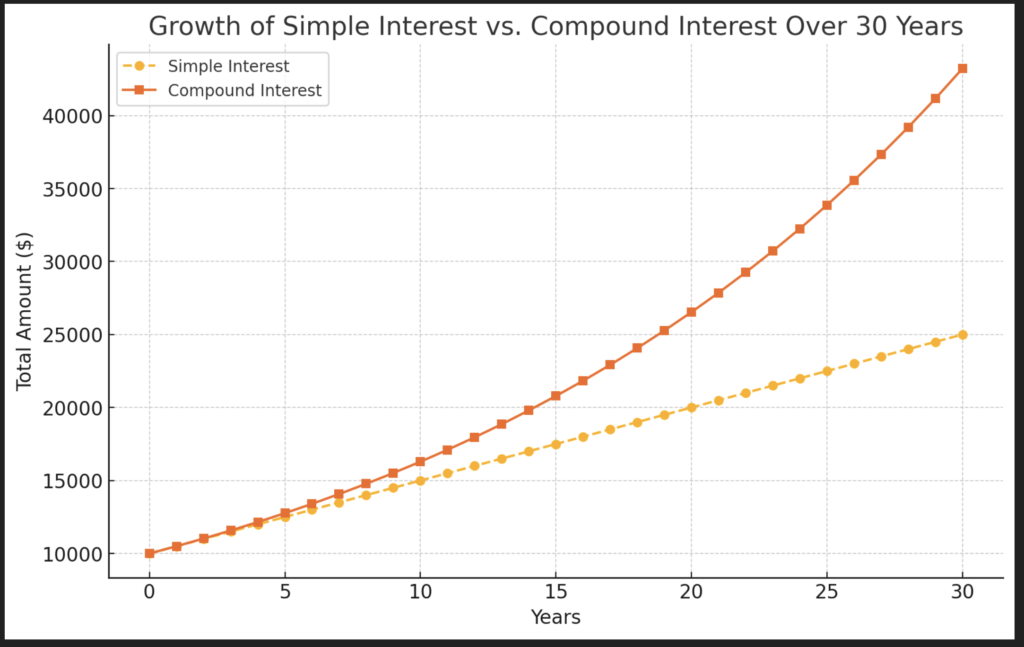Do you know if your retirement savings will provide enough income?
Nearly 40% of retirees discover too late that their annuity payments fall short of their needs, forcing difficult lifestyle changes.
Our Annuity Calculator lets you test different scenarios before you commit, showing you exactly how your savings choices today will affect your monthly income tomorrow.
Annuity Calculator
Results
Input Variables
- Currency:
The monetary unit (e.g., $, €, £, ¥) that updates both the input labels and the output display, ensuring consistency in financial representation. - Initial Principal:
The starting amount of money that is invested before any regular contributions are made. - Regular Payment:
The amount added at each payment interval. This value represents the recurring deposits made over time. - Annual Interest Rate:
The yearly interest rate (in percentage) that determines how much the invested money grows each year. - Number of Years:
The total duration (in years) over which the annuity calculations are performed. - Payment Frequency:
How often the regular payments are made (e.g., monthly, quarterly, annually). This impacts the total number of payments over the investment period. - Compounding Frequency:
The number of times per year that the interest is compounded. This affects the overall growth of the investment by influencing how often interest is calculated and added to the principal. - Payment Timing:
Indicates whether payments are made at the beginning (annuity due) or at the end (ordinary annuity) of each period. Payments made at the beginning have an extra period of compounding compared to those made at the end.
Annuity Calculator: Securing your Financial Future
Introduction to Annuities

What Is an Annuity?
An annuity is a contract between you and an insurance company.
You make a lump sum payment or series of payments, and in return, the insurer agrees to make periodic payments to you, starting immediately or at some point in the future.
You are making sure that in the future, you have a fixed “pay check”. For this in the financial market, this is a “Future” or “Forward” on a salary.
Why They Matter in Financial Planning

Traditional pensions are disappearing and Social Security faces uncertainty, annuities can fill a critical gap.
Using our pension annuity calculator can help give you guidance on how well your set for your retirement.
Annuities provide something that’s become increasingly rare: guaranteed income for life.
Unlike your 401(k) or IRA, which might run dry if you live longer than expected or if the market tanks at the wrong time, certain annuities can guarantee income until you die – even if you live to 110.
Types of Annuities
There’s no one-size-fits-all annuity. Here’s how they break down:
Fixed Annuities: Predictability is King

Fixed annuities work similarly to certificates of deposit but typically offer higher interest rates. The insurance company guarantees both the rate of return and the payout amount.
I’ve seen many pre-retirees use these as the “boring but dependable” part of their retirement portfolio. If you’re the type who checks their investment apps hourly, fixed annuities might reduce your stress levels considerably.
Variable Annuities: Linking to Market Performance
Variable annuities come with investment options (sub-accounts) similar to mutual funds. Your returns fluctuate based on the performance of these investments.
I’ve found these appeal to investors who want growth potential but still desire the annuity structure. The downside? Higher fees and more complexity. Don’t rush into these without understanding exactly what you’re buying.
Indexed Annuities: The Middle Path
Indexed annuities attempt to give you the best of both worlds – they’re tied to market indices like the S&P 500, but with floors that protect against losses.
The trade-off is that your gains are typically capped. You might get 60% of the market’s upside with none of the downside. For many of my clients approaching retirement, this balance makes sense.
Immediate vs. Deferred: When Do You Need the Money?

Immediate annuities start paying out right away (within a year of purchase). They’re ideal if you’re already retired or about to retire.
Deferred annuities, meanwhile, grow your money for a period before payments begin. I often recommend these to clients who are 5-15 years from retirement and want to create a future income stream.
How Annuities Work
The Two Phases Every Investor Should Understand
Annuities operate in two distinct phases:
- Accumulation Phase: This is when your money grows, either through interest (fixed), market returns (variable), or a combination (indexed).
- Payout Phase: This is when you start receiving payments, either as a lump sum, for a fixed period, or for life.
The contract terms determine everything from payout options to what happens if you die prematurely. This isn’t the time to skim the fine print.
The Power of Compound Interest in Annuities

Compound interest works the same magic in annuities as it does elsewhere in finance. The difference is that annuities offer tax-deferred growth, meaning you don’t pay taxes on the earnings until you withdraw them.
This creates a snowball effect where your money grows on top of itself without annual tax drag.
Using an Annuity Calculator
To get a realistic picture of what an annuity might do for you, you’ll need to input:
- Your initial investment
- Any ongoing contributions
- Expected interest rate
- Time horizon
- Payout period
The calculator will show you the future value, total contributions, and interest earned. This helps quantify the difference between various annuity types and terms.
Like this calculator? Try out some of our other Financial Calculators
- Debt vs Investment Calculator
- Salary Sacrifice Calculator
- ISA Calculator
- AER Calculator
- Savings Goal Calculator
- Compound Interest Calculator
Benefits of Annuities
Guaranteed Income: Sleep Well at Night

The primary advantage of many annuities is the guaranteed income stream. In volatile markets, knowing that a certain amount will arrive every month regardless of market conditions provides significant peace of mind.
I’ve seen this benefit transform retirement planning discussions from anxiety-filled to confident for many clients.
Tax-Deferred Growth: Keep More of Your Money Working
Annuities grow tax-deferred, meaning you don’t pay taxes on the earnings until you withdraw them. This can significantly impact long-term growth.
For high-income earners who’ve maxed out their 401(k) and IRA contributions, annuities offer additional tax-advantaged space with no contribution limits.
Risk Management: Balancing Your Portfolio
Annuities can serve as the conservative anchor in a diversified portfolio. While your stocks and more aggressive investments pursue growth, annuities provide stability and guaranteed returns.
This balance becomes increasingly important as you approach and enter retirement.
Considerations & Risks
Fees: Know What You’re Paying
Annuities aren’t free. Common fees include:
- Administrative fees
- Mortality and expense risk charges
- Underlying fund expenses (in variable annuities)
- Surrender charges (if you withdraw early)
Some variable annuities can charge 3-4% annually all-in. That’s a high hurdle to clear before seeing real returns. Always ask for a detailed fee breakdown.
Market & Inflation Risks: The Fine Print
Fixed annuities offer certainty but may not keep pace with inflation. A fixed payment that seems adequate today might lose significant purchasing power over a 20-30 year retirement.
Variable annuities offer inflation protection through potential growth but introduce market risk. There’s no free lunch here.
Liquidity Constraints: Can You Access Your Money?
Most annuities impose surrender charges if you withdraw more than a specified amount (typically 10% annually) during the surrender period, which can last 7-10 years.
Before purchasing, honestly assess whether you might need the money early. I’ve seen too many investors trapped by surrender charges they didn’t fully understand.
Annuity Calculator: Planning Your Financial Future
Step-by-Step Guide to Using an Annuity Calculator
A good annuity calculator should allow you to input:
- Initial investment amount
- Additional contributions (if any)
- Interest rate/expected return
- Time until payout begins
- Payout period (years or lifetime)
- Optional features (inflation adjustment, etc.)
Play with different scenarios. What happens if you delay retirement by two years? What if you increase your initial investment by 20%? The calculator brings these scenarios to life.
Interpreting the Results
The calculator will show you:
- Total accumulated value
- Total contributions made
- Total interest earned
- Monthly/annual payout amounts
These figures help you determine if an annuity fits your retirement income needs and how it compares to other investment strategies.
Real-World Example
Let’s say you’re 55, planning to retire at 65, and considering a $100,000 fixed annuity with a 4% guaranteed rate. The calculator might show:
- Accumulated value at 65: $148,024
- Monthly lifetime income starting at 65: $740
Is this enough to supplement your other retirement income? That depends on your specific situation.
Annuities in Your Retirement Portfolio
Strategic Integration
Rather than viewing annuities as an all-or-nothing proposition, I recommend the bucketing approach:
- Liquid assets for short-term needs (cash, money market)
- Growth assets for long-term needs (stocks, real estate)
- Guaranteed income for essential expenses (annuities, pensions)
This provides both security and growth potential.
Comparative Analysis
When comparing annuities to other retirement income sources:
- Social Security offers inflation protection but may face future benefit reductions
- Traditional pensions provide guaranteed income but are increasingly rare
- Bond ladders offer more liquidity but less longevity protection
- Dividend stocks offer growth potential but no income guarantees
The right mix depends on your risk tolerance, other income sources, and legacy goals.
Tax Implications of Annuities
The Tax Deferral Advantage
Earnings in an annuity grow tax-deferred, meaning you don’t pay taxes until you withdraw the money. This allows your money to compound more efficiently over time.
However, unlike qualified retirement accounts (401(k)s, IRAs), contributions to annuities are made with after-tax dollars.
Taxation During Withdrawal Phase
When you start taking distributions, a portion of each payment is considered a return of principal (tax-free), and a portion is considered earnings (taxable as ordinary income).
This is calculated using an “exclusion ratio” based on your life expectancy and total investment.
Tax Planning Strategies
To minimize tax impact:
- Consider purchasing annuities within an IRA for additional tax benefits
- Spread annuity purchases over multiple years to diversify tax liability
- Explore Qualified Longevity Annuity Contracts (QLACs) to reduce Required Minimum Distributions from other retirement accounts
Conclusion
Are Annuities Right for You?
Annuities aren’t perfect for everyone, but they can play a valuable role in many retirement plans. They make the most sense if you:
- Value guaranteed income over maximum growth potential
- Want to ensure you don’t outlive your savings
- Have maxed out other retirement accounts
- Seek tax-deferred growth opportunities
They make less sense if you:
- Need immediate access to all your capital
- Can’t afford to lock up your money long-term
- Are in a low tax bracket
- Are still far from retirement with a high risk tolerance
Next Steps
I recommend using an annuity calculator to run through scenarios specific to your situation. Then, consult with a financial advisor who operates on a fiduciary standard (legally obligated to put your interests first).
The right annuity, properly integrated into your overall financial plan, can provide valuable peace of mind and income security. The wrong one can lock up your money in an inflexible, fee-heavy product that doesn’t serve your needs.
As with most financial decisions, the devil is in the details. Take your time, do your homework, and make sure any annuity you purchase aligns with your long-term financial goals.
Have you considered including annuities in your retirement planning? What questions or concerns do you have about them?
FAQ
What is an annuity?
An annuity is a financial product that insurance companies sell. You pay money to the company either as one big payment or as several small payments. The insurance company invests this money. Later, the company pays you back in regular installments. These payments can last for a set time or for your whole life.
What types of annuities exist?
Three main types of annuities exist:
Fixed annuities – These give you a set rate of return
Variable annuities – These link to market performance
Indexed annuities – These connect to a market index like the S&P 500
Your risk comfort level and money goals will help you pick the right type.
How does an Annuity Calculator help?
An Annuity Calculator shows what your future income might be. It uses facts like:
Your starting investment
When you add money
Your return rate
Your payment options
This tool shows how much monthly or yearly income you might get, which helps you plan for retirement.
Are there penalties for early withdrawals?
Yes. Most annuity contracts charge fees if you take money out too soon or before you reach retirement age. Also, if you withdraw before age 59½, you might pay a 10% penalty to the IRS (if this applies where you live). Always check your specific annuity terms.
What should I think about when choosing an annuity?
Key points to consider include:
Your age now
When you plan to retire
How much risk you can accept
When you want to get paid
What fees or penalties might apply
You should also look at different annuity products and rates from various companies to find the best choice for your retirement plans.
